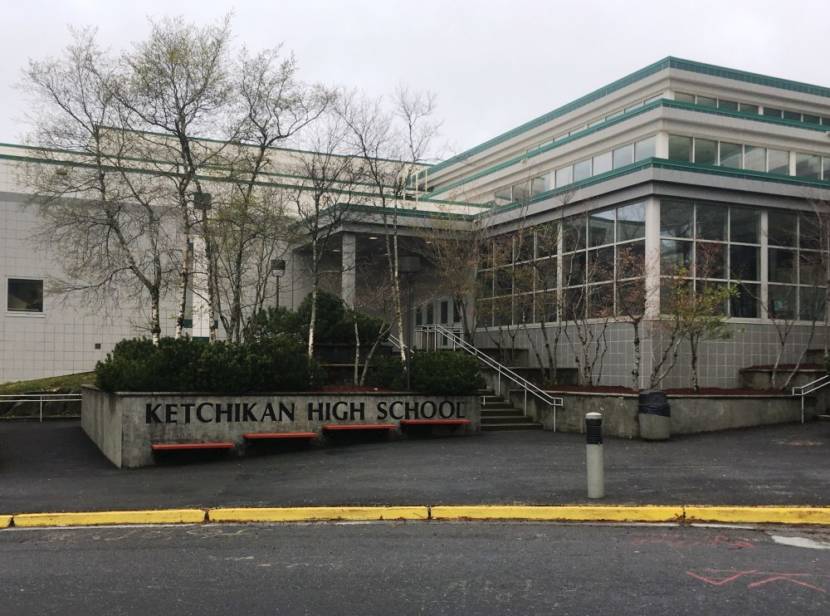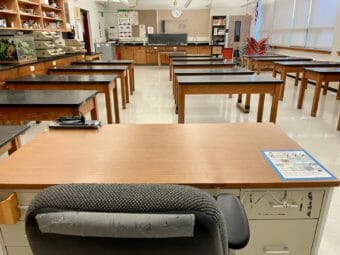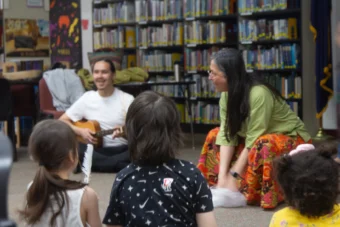
School districts around the state are grappling with holes in their budgets for the coming school year.
In Ketchikan, district officials are looking at cutting nearly 60 positions, but they’re hopeful that the Alaska Legislature will ease the pressure by boosting state education funding.
Ketchikan’s school district is looking at cutting about 15% of its workforce.
“And that is across the whole school district, with maintenance, IT, administration, teachers,” Superintendent Michael Robbins said in a phone interview Monday.
Part of the problem, he said, is that there simply aren’t as many kids attending Ketchikan schools as there once were. Next year, enrollment is projected to be down by more than 300 students from 2019.
“That’s a 13% drop in enrollment over the last four years, so that’s a pretty significant drop,” he said.
Some students might be moving to private schools. But Robbins said the vast majority of the drop is simply due to the fact that fewer people are raising their children here.
“Predominantly, we found that students are and families are leaving,” he said.
That’s in line with statewide trends. Alaska’s population is aging, and fewer people are raising kids in the state.
The president of Ketchikan’s teachers union, Sarah Campbell, said in an interview that she’s concerned about the impacts a shrinking school system could have on Ketchikan and the state as a whole.
“We’re in the midst of a national teacher shortage. and yet in Alaska and here in Ketchikan, we’re talking of cutting staff,” she said. “That concerns me deeply as a lifelong Ketchikan resident, and as somebody who hopes to have grandkids in our school system.”
Declining enrollment is just one piece of the problem. Robbins and Campbell point to state education funding as another.
Next year, school districts are scheduled to receive a little under $6,000 per student. That’s about what it’s been for the past six years. The Legislature voted last year to increase the per-student amount, known as the base student allocation, by $30 bucks a kid. That’s 0.5%.
Meanwhile, Robbins says costs are rising. Quickly.
“Through inflation, increases in energy costs, increases in transportation costs with gasoline … budgeting has been very difficult for us,” he said.
Ketchikan might be worse off than others. After years of underfunding, the district is planning to put millions more towards its health insurance program this year.
But districts across the state are feeling the pain. They’ve cut costs. That means fewer teachers and fewer programs available for students.
Homer teacher Tim Daugherty recently told the state Senate Education Committee that his local schools have cut key activities.
“Our shops were open — not only to the kids, to the community for coming in after school. We had active not just sports programs, we had debate and drama and music, and they were all top notch. We’ve lost those things,” he said at a hearing on Monday.
And Sitka High School student Felix Myers said similar cuts in his district are hurting students.
“We are now down to the bare bones, as many others have testified, and what that means is that with every teacher lost, you’re cutting a program,” he told the committee. “And when you cut the program, you’re cutting students’ will to come to school.”
Many districts are struggling to fill basic jobs like custodians, cafeteria workers and teachers. In Nome, School Board President Sandy Martinson told lawmakers that her district loses about 20% of her staff every year. She says the salaries she’s able to offer just don’t cover the costs of life in rural Alaska. She’s calling for more funding.
“Increasing the BSA that would help us support our teacher retention, and provide for the much needed costs of living in a remote community,” she said.
And lawmakers are considering it. Senate Bill 52 is circulating which would hike the per-student figure by $1,000.
Ketchikan’s Borough Assembly recently endorsed the bill as part of a joint resolution with the local school board. Robbins, the Ketchikan superintendent, says it would provide $6 million for the district if passed, which he says would help close the gap.
Senate Education Committee Chair Löki Gale Tobin, an Anchorage Democrat, says adequate education funding is the “chief priority” of the bipartisan Senate Majority caucus. She says the proposed $1,000 increase is the “beginning of a conversation.”
Ketchikan independent Rep. Dan Ortiz says he’d like to get the conversation started in the lower house of the Legislature, too.
“I’m going to be introducing a bill that would increase the BSA (by) $1,250 rather than $1,000, and so, we’ll see where that goes,” he said in a phone interview Monday. “That’s mainly just to get the discussion going on the House side.”
Ortiz says increasing education funding is an investment in the state’s future.
“I used to teach economics, and they talked about how, in the end, (in) any economy, the human capital in that economy is the most valuable resource that you’re going to have,” he said.
But it’ll be a tough conversation. Adding $1,000 to per-student funding would increase the state budget by more than $250 million, according to nonpartisan legislative analysts. That’d likely require a cut to other state expenses — including Gov. Mike Dunleavy’s proposal to pay Permanent Fund dividends of more than $3,800.
Sen. Bert Stedman, a Sitka Republican representing much of coastal Southeast Alaska, put it this way.
“We’re going to have to make a choice. Do we want to teach our kids to cash checks? Or do we want to teach them to read and write and do arithmetic?” he said at a Feb. 1 news conference. “That’ll be the fundamentals of the debate.”
More hearings on the bill are expected in the weeks ahead.


